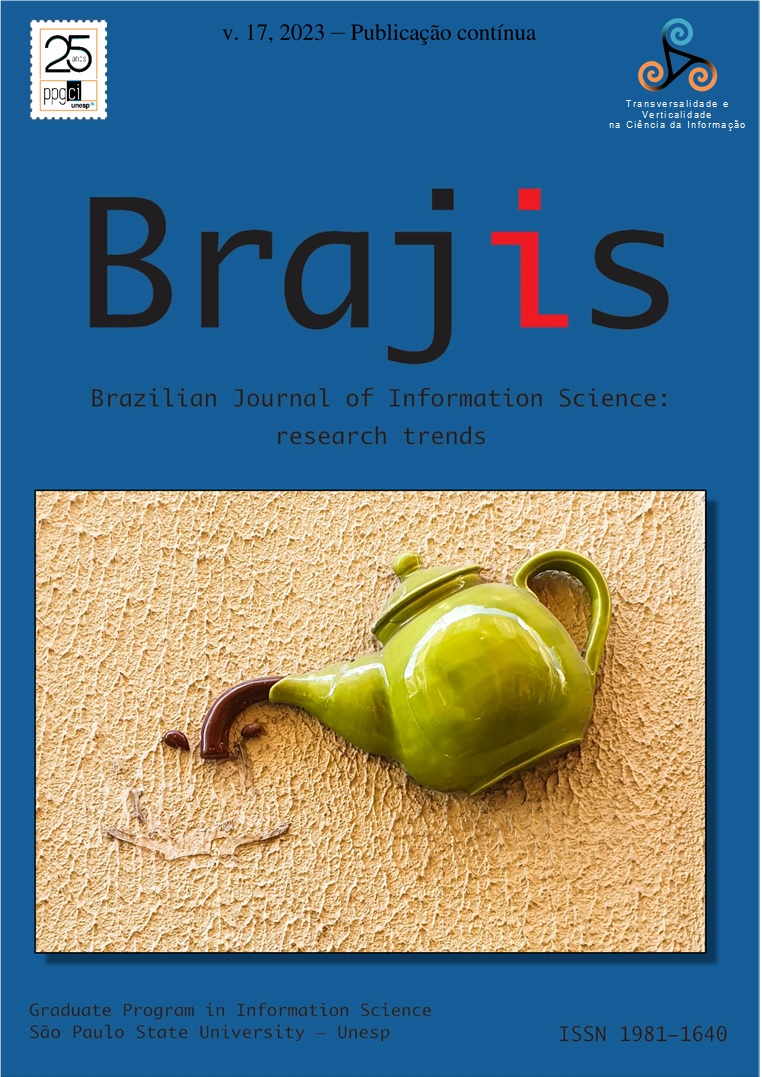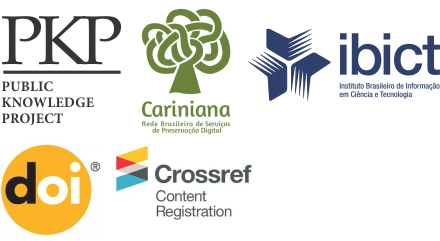Inbound marketing and user experience and their potential convergences in the context of digital social media
projections through the perspective of Information Science
DOI:
https://doi.org/10.36311/1981-1640.2023.v17.e023049Keywords:
Social media marketing, On-line communication, Social platforms, User interactionAbstract
In a society where information is both produced and consumed by various agents concurrently, the endeavor to achieve prominence within the vast realm of information has become an increasingly challenging task. In this context, businesses have turned to digital channels to reach new consumers and foster loyalty among existing clients. For this reason, this present article aims to facilitate a theoretical discussion of concepts related to inbound marketing, user experience, and social media, within the framework of the field of Information Science. To accomplish this objective, a comprehensive theoretical foundation was constructed through a thorough review of relevant literature, underpinning the proposed discourse. As a result, the observed conceptual relationships have highlighted convergences between the subject matters, as both underscore the importance of comprehending user characteristics and devising tailored experiences. Furthermore, this emphasizes the significance of this theme within the domain of Information Science, which stands to benefit significantly from an enhanced understanding of these strategies and their role in the realm of digital social media. In conclusion, it is evident that there are intersections among the analyzed themes, which align with the essential knowledge base required for the current practice of Information Science professionals.
Downloads
Metrics
References
Almeida, S. S. “Estratégias de inbound marketing em uma indústria 3.0”. Revista Gestão Da Produção Operações e Sistemas, vol. 14, no. 3, 2019, pp. 1-13, doi:10.15675/gepros.v14i3.2527.
Alwan, M., e Alshurideh, M. T. “The effect of digital marketing on purchase intention: moderating effect of brand equity”. International Journal of Data and Network Science, vol. 6, no. 3, 2022, pp. 837–848, doi:10.5267/j.ijdns.2022.2.012.
Baranchenko, Y., et al. “Inbound marketing: practical aspects of promoting goods and services in e-commerce”. Marketing and Management of Innovations, no. 4, 2019, pp. 308–320, doi:10.21272/mmi.2019.4-2410.21272/mmi.2019.4-24.
Barbosa, S. D. J., e Silva, B. S. Interação humano-computador. Elsevier, 2010.
Bauer, C. H. Marketing digital: o desenvolvimento de um guia para a construção de presença em um cenário digital, 2022. Universidade Federal de Santa Catarina, Trabalho de Conclusão de Curso.
Benedikt, M. “Cyberspace: some proposals”. Cyperspace: first steps. Editado por M. Benedikt. The MIT Press, 1992, pp. 119–224.
Benz, P., editor. Experience design: concepts and case studies. Bloomsbury Academic, 2015.
Boyd, D., e Ellison, N. “Social network sites: definition, history, and scholarship”. Journal of Computer-Mediated Communication, vol. 13, no. 1, 2007, pp. 210–230, doi:10.1111/j.1083-6101.2007.00393.x.
Brandtzæg, P. B., et al. “Enjoyment: lessons from karasek”. Editado por M. A. Blythe, et al. Funology: from usability to enjoyment. Kluwer Academic Publishers, 2004. pp. 55–66.
Camacho, D. Marketing digital: compra de mídia e inbound. Editora Senac, 2019.
Castells, M. A sociedade em rede. Paz e Terra, 2011.
Dantas, E. B. “A informação como insumo na prática do marketing: possibilidade de capturar o conhecimento do cliente”. Informação & Sociedade: estudos, vol. 16, nº 1, 2006. pp. 35–47, https://www.brapci.inf.br/_repositorio/2010/11/pdf_5596d4f67c_0012841.pdf. Acessado 07 ago. 2023.
Ferreira, D. T. “Profissional da informação: perfil de habilidades demandadas pelo mercado de trabalho”. Ciência Da Informação, vol. 32, no. 1, 2003, pp. 42–49, doi:10.1590/s0100-19652003000100005.
Fredheim, H. “Why user experience cannot be designed”. Smashing Magazine, 2011, https://www.smashingmagazine.com/2011/03/why-user-experience-cannot-be-designed. Acessado 19 jun. 2023.
Freire, K. “Reflexões sobre o conceito de design de experiências”. Strategic Design Research Journal, vol. 2, no. 1, 2009, pp. 37–44, doi:10.4013/sdrj.2009.21.05.
Gould, J., e Lewis, C. “Designing for usability: key principles and what designers think”. Communications of the ACM, vol. 28, no. 3, 1985, pp. 300–311, doi:10.1145/3166.3170.
Hassenzahl, M. “The thing and i: understanding the relationship between user and product”. Editado por M. Blythe, et al. Funology: from usability to enjoyment. Países Baixos: Kluwer Academic Publishers, 2004. pp. 31–42.
Hassenzahl, M. Experience design: technology for all the right reasons. Morgan & Claypool, 2010.
Hassenzahl, M., e Tractinsky, N. “User experience: a research agenda”. Behaviour & Information Technology, vol. 25, no. 2, 2006, pp. 91–97, doi:10.1080/01449290500330331.
Ideo.Org. The field guide to human-centered design. IDEO.org, 2015.
International Organization for Standardization. ISO 9241-210: ergonomics of human–system interaction — part 210: human-centred design for interactive systems. Suíça, 2010.
Kaplan, A., e Haenlein, M. “Users of the world, unite! The challenges and opportunities of social media”. Business Horizons, vol. 53, no. 1, 2010, pp. 59–68, doi:10.1016/j.bushor.2009.09.003.
Kierzkowski, A., et al. “Marketing to the digital consumer”. Internet Research: Electronic Networking Applications and Policy, Nova Iorque, vol. 4, no. 3, 1996. pp. 5–21, https://bit.ly/3QKwSOe. Acessado 07 ago. 2023.
Kotler, P., et al. Marketing 5.0: tecnologia para a humanidade. Sextante, 2021.
Kotler, P., e Keller, K. L. Administração de marketing. Pearson Education do Brasil, 2012.
Lelis, H. R., et al. “As necessidades do usuário da informação e as habilidades e competências do moderno profissional da informação”. Revista Conhecimento Em Ação, vol. 6, no. 1, 2021, pp. 101–121, doi:10.47681/rca.v6i1.41554.
Lies, J. “Marketing intelligence and big data: digital marketing techniques on their way to becoming social engineering techniques in marketing”. International Journal of Interactive Multimedia and Artificial Intelligence, vol. 5, no. 5, 2019, pp. 134, doi:10.9781/ijimai.2019.05.002.
Lomborg, S. Social media, social genres: making sense of the ordinary. Taylor Francis, 2014.
Lévy, P. Cibercultura. Editora 34, 2010.
Madeira, C. G., e Gallucci, L. “Mídias sociais, redes sociais e sua importância para as empresas no início do século xxi”. Congresso brasileiro de ciências da comunicação, Curitiba, 2009. Curitiba: Sociedade Brasileira de Estudos Interdisciplinares da Comunicação. pp. 1-15, http://intercom.org.br/papers/nacionais/2009/resumos/r4-1163-1.pdf. Acessado 07 ago. 2023.
McLellan, H. “Experience design”. CyberPsychology & Behavior, vol. 3, no. 1, 2000, pp. 59–69, doi:10.1089/109493100316238.
Nunes, M. Cyberspaces of everyday life. University of Minnesota Press, 2006.
Oliveira, D. M., et al. “Habilidades e competências do profissional da informação”. Encontro Nacional de Pesquisa e Pós-Graduação Em Ciência Da Informação, 2019, https://recipp.ipp.pt/handle/10400.22/15232. Acessado 07 ago. 2023.
Opreana, A., e Vinerean, S. “A new development in online marketing: introducing digital inbound marketing”. Expert Journal of Marketing, vol. 3, no. 1, 2015. pp. 29–34, https://marketing.expertjournals.com/23446773-305/. Acessado 07 ago. 2023.
Ortiz-Ospina, E. “The rise of social media”. Social Media Fact Sheet, 2021, https://ourworldindata.org/rise-of-social-media?ref=tms. Acessado 24 out. 2023.
Pew Research Center. “Social media fact sheet”. Pew Research Center, 2021, http://bit.ly/406cyJW. Acessado 11 out. 2023.
Pine II, D. J., e Gilmore, J. H. “Welcome to the experience economy”. Harvard Business Review, vol. 3, no. 1, 1998. pp. 95–106.
Quaresma, M., et al. “Ux concepts and perspectives: from usability to user experience design”. Editado por M. M. Soares, et al. Handbook of usability and user-experience: research and case studies. Boca Raton: CRC Press, 2022. pp. 1–14.
Recuero, R., et al. Análise de redes para mídias sociais. Sulina, 2015.
Reza Kiani, G. “Marketing opportunities in the digital world”. Internet Research, vol. 8, no. 2, 1998, pp. 185–194, doi:10.1108/10662249810211656.
Salvador, Â. D. Métodos e técnicas de pesquisa bibliográfica: elaboração e relatório de estudos científicos. Sulina, 1973.
Saracevic, T. “Ciência da informação: origem, evolução e relações”. Ciência da Informação, vol. 1, no. 1, 1996. pp. 41–62, https://periodicos.ufmg.br/index.php/pci/article/view/22308. Acessado 07 ago. 2023.
Shankar, V., et al. “Digital marketing communication in global marketplaces: a review of extant research, future directions, and potential approaches”. International Journal of Research in Marketing, vol. 39, no. 2, 2022, pp. 541–565, doi:10.1016/j.ijresmar.2021.09.005.
Soares, M., et al. “Usability and user experience: methods and models”. Editado por M. M. Soares, et al. Handbook of usability and user experience: methods and techniques. Boca Raton: CRC Press, 2022. pp. 3–22.
Soegaard, M. The basics of user experience (ux) design. Interaction Design Foundation, 2018.
Special Libraries Association. “Competencies for information professionals”. Special Libraries Association, 2016, https://www.sla.org/about-sla/competencies/. Acessado 11 jul 2023.
Stati, C, R. e Sarmento, C. F. Experiência do usuário (ux). InterSaberes, 2021.
Steenburgh, T., et al. “Hubspot: inbound marketing and web 2.0”. Harvard Business School, Boston, 2011. pp. 541–565, https://www.hbs.edu/faculty/Pages/item.aspx?num=37327. Acessado 07 ago. 2023.
Torres, C. A bíblia do marketing digital. Novatec, 2009.
Volles, B. K., et al. Web marketing. Uniasselvi, 2018.
Zart, D. C., e Durayski, J. “Inbound marketing: análise do lançamento de um produto digital”. Univates, 2016, vol. 1, no. 1, pp. 1–34, https://bit.ly/3E446As. Acessado 07 ago. 2023.
Świeczak, W. “Inbound marketing as an integral part of the marketing strategy of a modern enterprises”. Marketing Instytucji Naukowych i Badawczych, 2014, vol. 12, no. 2, pp. 57–77, http://bit.ly/3KL4GHf. Acessado 07 ago. 2023.
Published
How to Cite
Issue
Section
License
Copyright (c) 2023 Cássio Henrique Bauer, Sonali Paula Molin Bedin

This work is licensed under a Creative Commons Attribution-ShareAlike 4.0 International License.
When submitting an article, the authors retain the copyright of the article, giving full rights to the Brazilian Journal of Information Science to publish the text.
The author(s) agree that the article, if editorially accepted for publication, shall be licensed under the Creative Commons Attribution-ShareAlike 4.0 International (CC BY-SA 4.0) license (http://creativecommons.org/licenses/by-sa/4.0) Readers/users are free to: - Share — copy and redistribute the material in any medium or format - Adapt — remix, transform, and build upon the material for any purpose, even commercially. The licensor cannot revoke these freedoms as long as you follow the license terms. Under the following terms: - Attribution — You must give appropriate credit, provide a link to the license, and indicate if changes were made. You may do so in any reasonable manner, but not in any way that suggests the licensor endorses you or your use. - ShareAlike — If you remix, transform, or build upon the material, you must distribute your contributions under the same license as the original. No additional restrictions — You may not apply legal terms or technological measures that legally restrict others from doing anything the license permits. Notices: - You do not have to comply with the license for elements of the material in the public domain or where your use is permitted by an applicable exception or limitation. - No warranties are given. The license may not give you all of the permissions necessary for your intended use. For example, other rights such as publicity, privacy, or moral rights may limit how you use the material.
 Creative Commons Attribution-ShareAlike 4.0 International License.
Creative Commons Attribution-ShareAlike 4.0 International License.












